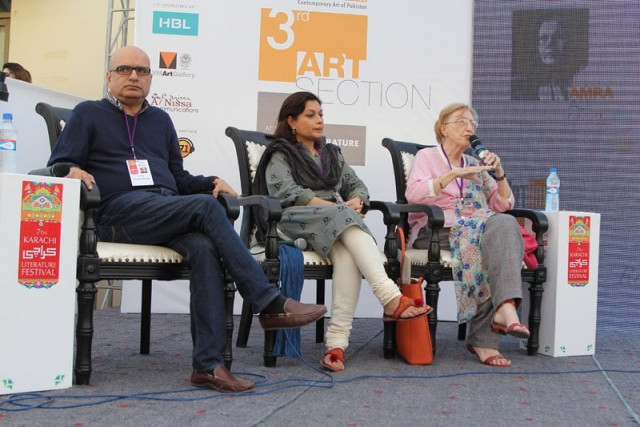‘Artists do not read, neither do art students’
Quddus Mirza says writing and making art are two sides of the same coin

Artist and art critic Quddus Mirza added to the misery of the art writer on Friday by saying that even artists do not read what we write, neither do art students. PHOTO: EXPRESS/ AYESHA SALEEM
Writing on art can be a challenge. Being an art writer, one can never be sure if their work has an audience. Artist and art critic Quddus Mirza added to the misery of the art writer on Friday by saying that even artists do not read what we write, neither do art students.
He was speaking at the session titled ‘The Art of Writing’ on the first day of the 7th Karachi Literature Festival at the Beach Luxury hotel. “The reason why I came into writing on art was because I was so sick of reading reviews on my own exhibitions that I thought at least I can write, if not better than these, but something kind of parallel to that,” he said. “I think writing on art and making art are two sides of the same coin - one is the tail, the other is the head. I don’t know which one is the head and which is the tail.” According to Mirza, writing on art is a laborious and thankless job as no one is going to read it. “Artists, by and large, don’t really read,” he said. “Even art students don’t read.”
Show me a soft image of Pakistan and I will present it: Hina Rabbani Khar
Art critic Amra Ali explained how she got involved with writing on art. “My minor was art history but I had no idea that I would one day become an art critic,” she said. “I used to look at the critic as a sort of very derogatory space. [Reading art reviews,] I was disillusioned. All that baggage of terminology and history, I couldn’t connect with it. That is not what art writing ought to be.”
 PHOTO: AYESHA SALEEM
PHOTO: AYESHA SALEEMAccording to Homeboy author HM Naqvi, who has started writing on art after fiction, art criticism does not have the resilience that it should have. He said that the curator has become more important than the critic. “The market is more of a driver than intellect,” he said. “I feel that in Pakistan, historically, art has existed in a critical vacuum. In recent years, however, there has been a wonderful proliferation of galleries and publications like Nukta[Art].”
‘Don’t hold back, just do it’
“I’m not formally trained in art history,” he said, addressing the moderator, Maliha Noorani. “I’m a layman, hum gavaar hain, hum aap ki tarha specialist nahin is liye hum ne socha hum kahaniyaan sunatay hain [I am backward, not a specialist like you, so I thought of narrating stories].” He explained how he used to go to Bhopal House to see the half-complete works of late artist Asim Butt. “He used to think and I used to think with him. I don’t know if I will continue writing about art.”
Nigaah Art Magazine publisher Tauqeer Muhajir lamented that many artists are unable to write their own artist statements in English. Art critic Marjorie Husain was asked by an audience member if increasing religiosity has affected the art scene in Pakistan. “During the time of martial law when a lot of people were going in for calligraphy, I spoke to [artist] Jamil Naqsh and said it’s such a bad time for art,” she reminisced. “And he said, no, it’s a very good time for art [as] nobody comes into your studio, you can paint what you want. We have to realise that painters are not always appreciated in their lifetime.”
Published in The Express Tribune, February 6th, 2016.



















COMMENTS
Comments are moderated and generally will be posted if they are on-topic and not abusive.
For more information, please see our Comments FAQ